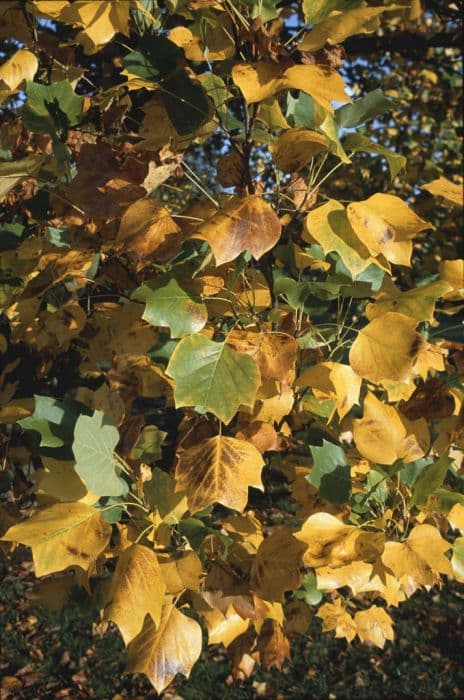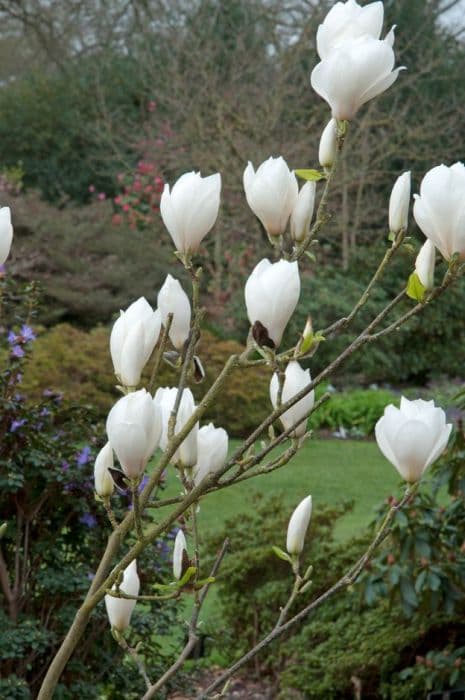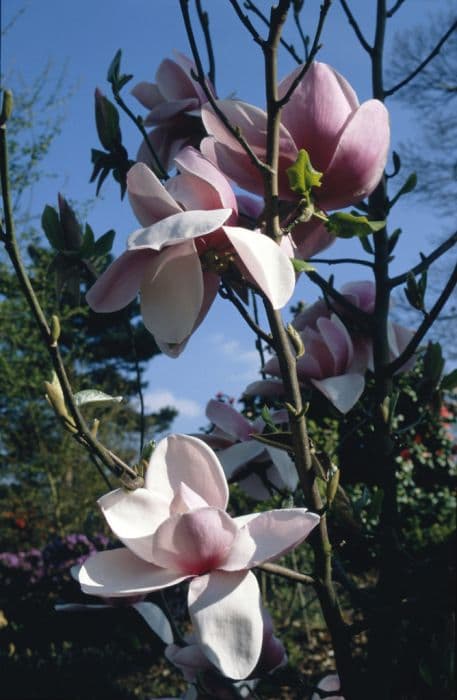Vulcan Magnolia Magnolia 'Vulcan'

ABOUT
The Magnolia 'Vulcan' is a striking flowering plant notable for its breathtaking blossoms. This cultivar is distinguished by its large, cup-shaped flowers that exhibit a rich and deep magenta coloration, which stands out against the backdrop of green foliage. The flowers possess a delicate, silky texture and are often described as having a somewhat tulip-like appearance due to their unique shape and size. Each flower comprises a series of broad, overlapping petals that unfurl gracefully as they bloom. The leaves of the Magnolia 'Vulcan' are glossy and dark green, providing a lush, dense canopy that beautifully contrasts with the intense color of the blooms. The foliage has an oblong to elliptical shape and a smooth, leathery texture, which adds to the plant's overall aesthetic appeal. During the flowering season, the Magnolia 'Vulcan' becomes the focal point of any garden with its vibrant flowers that emit a pleasant, subtle fragrance, attracting the attention of both passersby and pollinators alike. While this description emphasizes the visual beauty of the plant, it does not delve into specific measurements related to its size or dimensions. The Magnolia 'Vulcan' can become a treasure within a landscape, noted for both its showy flowers and pleasing, robust greenery that together create a stunning display.
About this plant
 Names
NamesFamily
Magnoliaceae
Synonyms
Vulcan Magnolia
Common names
Magnolia 'Vulcan'.
 Toxicity
ToxicityTo humans
Magnolia 'Vulcan', commonly known simply as Magnolia, is not considered toxic to humans. Therefore, ingestion of its parts typically does not result in poisoning or symptomatic consequences.
To pets
Magnolia, including the Magnolia 'Vulcan' variety, is also not considered toxic to pets. It is generally safe and does not cause poisoning if pets happen to ingest parts of the plant. There are typically no adverse symptoms associated with ingestion by pets.
 Characteristics
CharacteristicsLife cycle
Perennials
Foliage type
Deciduous
Color of leaves
Green
Flower color
Ruby-red
Height
10-12 feet (3-3.7 meters)
Spread
6 feet (1.8 meters)
Plant type
Tree
Hardiness zones
5
Native area
Hybrid
Benefits
 General Benefits
General Benefits- Aesthetic Appeal: The Magnolia 'Vulcan' offers large, vibrant, reddish-purple flowers that add striking color to the landscape.
- Fragrance: It emits a delightful fragrance from its blooms, which can enhance the sensory experience of a garden.
- Shade Provision: With its broad canopy, it provides ample shade in the garden or yard during the hot summer months.
- Habitat for Wildlife: The tree can serve as a habitat and food source for birds and beneficial insects.
- Year-Round Interest: It has a pleasing structure in winter, with its fuzzy buds adding interest to the bare branches.
- Low Maintenance: Once established, Magnolia 'Vulcan' is relatively low maintenance, requiring little care beyond occasional watering and pruning.
- Drought Tolerance: It is quite drought-tolerant, making it suitable for gardens in areas with less rainfall.
 Medical Properties
Medical PropertiesThis plant is not used for medical purposes.
 Air-purifying Qualities
Air-purifying QualitiesThis plant is not specifically known for air purifying qualities.
 Other Uses
Other Uses- Magnolia 'Vulcan' bark and leaves can be used to create natural dyes for fabrics, yielding subtle earthy tones depending on the mordant used.
- The flowers of Magnolia 'Vulcan' can be crystallized and used as edible decorations for desserts, adding a unique floral flavor and aesthetic appeal.
- Wood from the Magnolia 'Vulcan' tree can be crafted into small wooden items such as buttons, beads, or pendants for jewelry making.
- Dried Magnolia 'Vulcan' blooms are sometimes incorporated into potpourri mixes, contributing a light fragrance and an attractive visual element.
- The magnolia 'Vulcan' seed pods can be used in floral arrangements or crafts, adding texture and interest to the creations.
- Young foliage of Magnolia 'Vulcan' can be used as a unique filler in bouquets and floral decorations, offering a lush green backdrop.
- Magnolia 'Vulcan' petals can be used in homemade soaps for a light scent and to add visual flecks of color to the bars.
- The sturdy leaves of Magnolia 'Vulcan' can serve as natural canvases for painting or other artistic endeavors.
- Magnolia 'Vulcan' can be a source of mulch, where the fallen leaves provide a protective layer for soil in gardens and landscaping.
- The large leaves of the Magnolia 'Vulcan' can serve as wrappers for small, delicate gifts, adding a unique and eco-friendly touch to packaging.
Interesting Facts
 Feng Shui
Feng ShuiThe Magnolia is not used in Feng Shui practice.
 Zodiac Sign Compitability
Zodiac Sign CompitabilityThe Magnolia is not used in astrology practice.
 Plant Symbolism
Plant Symbolism- Purity: Magnolias are often associated with purity, due to their large white blossoms that are considered symbols of innocence and cleanliness.
- Dignity: The magnolia's impressive appearance and stately bearing convey a sense of dignity and nobility, making it a symbol of self-respect and pride.
- Perseverance: Magnolias are known for their ability to withstand harsh conditions, representing strength and the ability to endure difficult circumstances.
- Nobility: The magnolia tree's grandeur and longevity are often connected to a noble spirit and high moral standards.
- Feminine beauty: The delicate and pristine flowers of the magnolia are frequently associated with grace and the beauty of women.
- Hospitality: In the American South, the magnolia is a traditional symbol of hospitality, inviting and welcoming guests with its large, fragrant blooms.
 Water
WaterVulcan Magnolia requires consistent moisture, especially during its growing season in the spring and summer. It should be watered deeply once a week, providing about 1 to 1.5 gallons of water per session for young trees, ensuring the soil remains moist but not waterlogged. During hot, dry periods, the frequency may increase to twice a week. In the winter, reduce watering to when the soil is dry to the touch.
 Light
LightVulcan Magnolia thrives in full sun to partial shade. It should be planted in a spot where it receives at least four hours of direct sunlight a day, but it can tolerate some afternoon shade, especially in hotter climates. The ideal situation is morning sunlight with afternoon protection to prevent stress from intense heat.
 Temperature
TemperatureVulcan Magnolia prefers moderate temperatures and can tolerate a range of conditions. It's hardy and can withstand minimum winter temperatures down to about 20 degrees Fahrenheit. The plant's ideal growing temperatures are between 60 and 70 degrees Fahrenheit. Avoid planting in locations where temperatures regularly drop below 20 degrees Fahrenheit or soar above 90 degrees Fahrenheit for optimal health.
 Pruning
PruningVulcan Magnolia typically requires little pruning other than to remove damaged or diseased wood and to shape the plant if desired. The best time to prune is late winter or early spring before new growth starts. Occasional thinning of the branches may be necessary to maintain the tree's structure and health.
 Cleaning
CleaningAs needed
 Soil
SoilVulcan Magnolia prefers acidic, moist, well-draining soil with a pH of 5.0 to 6.5. A mix of peat, compost, and pine bark is ideal for maintaining the necessary acidity and moisture retention.
 Repotting
RepottingVulcan Magnolias are slow-growing and do not require frequent repotting; they can be repotted every 2 to 3 years or when root-bound.
 Humidity & Misting
Humidity & MistingVulcan Magnolia thrives in average outdoor humidity levels but can tolerate a wide range from slightly dry to moderately humid conditions.
 Suitable locations
Suitable locationsIndoor
Use acidic soil, place in bright indirect light.
Outdoor
Plant in acidic soil, full sun to partial shade.
Hardiness zone
5-9 USDA
 Life cycle
Life cycleThe Vulcan Magnolia starts as a seed that requires stratification to break dormancy, typically undergoing a cold period to simulate winter. After germination, the seedling emerges and begins to establish a root system and foliage. As a young plant, the Vulcan Magnolia enters a period of vegetative growth, expanding in height and girth while developing more complex roots and branches. The plant matures into an adult, at which point it begins to bloom annually, usually in early spring, producing large, deep pink to purple flowers before its leaves fully emerge. Over the years, the Vulcan Magnolia continues to grow, potentially reaching a medium size of 10 to 15 feet tall, with a similar spread, and it can live for several decades if given the proper care. As it ages, the tree may slow in growth, produce fewer flowers, and eventually enter senescence leading to its decline and death.
 Propogation
PropogationPropogation time
Spring-Early Summer
The most popular method of propagation for the Magnolia 'Vulcan', also commonly known as Vulcan magnolia, is through semi-hardwood cuttings, which are best taken during the summer months when the plant is actively growing but the new growth has begun to mature. In this process, a cutting of about 4 to 6 inches long is taken from a healthy, disease-free branch. The leaves on the lower half of the stem are removed, and the cut end is dipped into a rooting hormone to encourage root development. This treated cutting is then planted in a pot containing a mix of peat and perlite, ensuring good drainage and aeration. The pot is kept in a warm, humid environment, out of direct sunlight, and the soil is kept consistently moist until the cutting roots, which can take several weeks. Covering the cutting with a plastic bag can help retain humidity and improve the chances of a successful propagation. Once rooted, the new magnolia plant can be gradually acclimated to outdoor conditions and planted in the garden.








![Magnolia [Felix Jury]](/_next/image?url=https%3A%2F%2Fplants-admin.emdemapps.com%2Fimages%2Fplants%2F%2Fimages%2F604b61a0b23b7.png&w=640&q=75)
